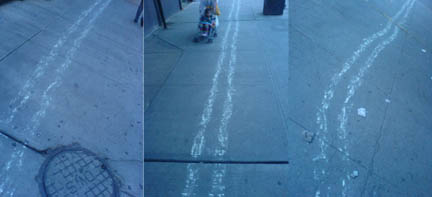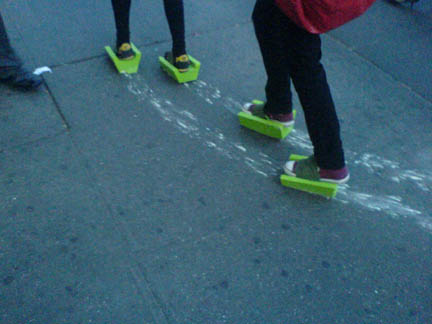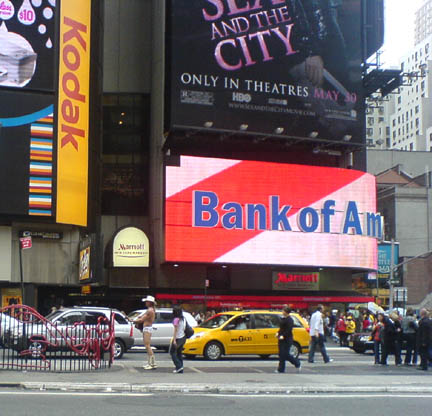Returning to New York City after a 20-year journey in Seattle and South Florida. New York taught me how to think art.
Psychologically, NYC has changed dramatically. Signs in the subway remind parents to keep baby carriages off the escalator. Street territory has been reapportioned for small plazas to hangout or walk more comfortably. Only a few of the former down-and-out residents of the street remain. The permanent abandonment of former brick tenements has ceased. Dark windows signal the wrecking ball and renewal, not the hopelessness.
Of course, the dark hopeless territories still exist, but many, many people can live and work in Manhattan rarely encounter the misery. In the 1980s when I organized artistic critiques of the civic abandonment, all peoples in Manhattan had to divert their hearts away from the people of the streets or the five stories of broken glass. We artists were saddened and angry at the diversion- but that anger sparked thought, energy and action through art or body or both.
On Wednesday, I revisited one of the most dangerous Manhattan zones in the 1980s – the meatpacking district. Today, the pristine storefronts are so numerous and trendy that both Samantha and Carrie from “Sex in the City” shopped there. I thought I was walking in some kind of strange dream where the fairy godmother swooped her wand and sparkled the filth into beautiful clothes for everyone.
One art gallery, Leo Keating Gallery, had sponsored an art event to raise money for the new Highline park that will open in a few months. The use of the old elevated rail tracks was a favorite student architecture project in the 80s and 90s. One of architect Steven Holl’s very early theoretical projects proposed housing on the tracks. Now after ten years of advocacy and fund raising, the Highline will become a public park – an important part of the literal greening of Manhattan.
To raise cash, the gallery was selling fluorescent green chalk shoes by Julia Mandle. Earlier in the month, she put shoes on various students from nearby schools and they drew a path on the sidewalk to the Highline. A simple idea to tell the children, their friends and their parents that the Highline was coming to the neighborhood. On the night of the gallery opening, she and a friend where making an apparently arbitrary path through the new glamour of the meat packing district. Following the path that evening would lead you to the gallery or to her on the shoes.

The gallery did not have significant posters about the Highline and the artist was not carrying any information with her. This absence of information is a very New York thing that does not happen in other parts of the USA. As I remember from days past, the New York art world believes that explanation apparently degrades the artwork. Converting the thing from art to advertising.

My new paying job is to create a consistent public art program for the Times Square Alliance. Advertising, not art, dominates Times Square. So my new work takes me straight to conflict between the instinct for ambiguous poetic connotations of art and the directive for the clear targets of advertising.
Yet the visitors to Times Square desire the unexpected. The protective judgments about art back home are abandoned in Times Square and the energy of strangeness is embraced. Instead of secrecy of naughty personal acts in the Vegas slogan “What happens here, stays here”, a visit to Times Square might generate a celebratory slogan like “Look what happened to me here”. The visitors snap pictures of every new billboard and ask a friend to record their strange encounters with Naked Cowboy or the two Statues of Liberty that graced Times Square today with a background of Peruvian flutes. What better place could exist for public art to receive the full acceptance of all types of folks?


Welcome back to NYC, and yes it has really changed. I had the same sense of shock and awe regarding the meatpacking district when I returned to NYC after a 7 year hiatus. It is interesting that I just read this today (a little behind in reading all of my feeds), last night I participated in a public conversation with Julia Mandle (we both create projects in the streets which seek to engage people with their surroundings). One of the more discussed topics was how, as artists in the street, we compete with all of the “advertising noise” that surround us every minute of every day. One of the methods of rising above the noise is to create a moment of curiosity – sometimes the handouts or labels or explanations distract from that. (Having said that, she had information available at Leo Kesting gallery – so if you followed the line in the right direction…)
I am pleased to hear that you will be working on projects in Time Square, as that is the penultimate location for trying to rise above the noise – maybe one solution is to do so with a quiet intervention…
Look forward to the fruits of your labor – and welcome back!
Hello Glenn,
I am excited to see what happend in Times Square with your new position. Please keep posting.
Robin Maria Pedrero
Welcome back to NYC. Interesting timing on this post – I was “in conversation” with Julia Mandle the other week, talking about both of our projects (which superficially have the chalk mark making in common, but in more depth share interests in raising awareness and sparking curiosity within the urban environment). We spoke about the lack of ‘handouts’ or information left after the mark has been made and about how to compete in a city with so much visual stimulus. We both chose (on these specific projects) to attract attention through action and subtlety. Other projects (and those of other friends) use the tools of advertising or subtly subvert them. Sometimes it means trying to be louder. In Times Square, that may be hard.
I look forward with anticipation to your programming, I am sure it will be very interesting!